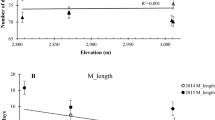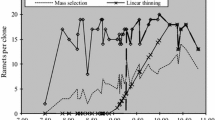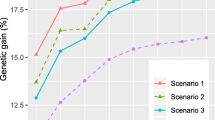Abstract
Self-pollen seldom results in vital genotypes and can thus be regarded as unimportant. Large-sized clones (clones with many ramets) are more exposed to self-pollen and spread more self-pollen and thus contribute relatively less than small-sized clones. The size of clones required to maximize genetic gain at given diversity, considering that only outcrossing contributes to successful gametes, was derived for tested clones intended to establish a Norway spruce (Picea abies) seed orchard. The derived optimal deployment was compared with linear deployment according to Lindgren and Matheson (Silvae Genet 35:173–177, 1986), where the size of a clone is deployed proportional to its breeding value. The study covered a range of effective numbers between 5 and 50. The results suggest that linear deployment is a good approximation to optimal deployment when only outcrossing is considered. The difference between the two strategies is decreased by increasing clone number and is negligible except at low effective numbers.



Similar content being viewed by others
References
Boije M (2001) Grankloner från 1983 års klonurval i zon 7. Skogforsk, Avelsvärden nr 86
El-Kassaby YA (2003) Clonal-row vs. random seed orchard designs: mating pattern and seed yield of western hemlock (Tsuga heterophylla (Raf.) Sarg.). For Genet 10:121–127
El-Kassaby YA, Russell J, Ritland K (1994) Mixed-mating in an experimental population of western red cedar, Thuja plicata. J Hered 85:227–231
El-Kassaby YA, Ritland K, Fashler AMK, Devitt WJB (1988) The role of reproductive phenology upon the mating structure of a Douglas-fir seed orchard. Silvae Genet 37:76–82
Kang KS, Harju AM, Lindgren D, Nikkanen T, Almqvist C, Suh GU (2001) Variation of ramet number and effective number of clones in seed orchards. New For 21(1):17–33
Koski V (1973) On self-pollination, genetic load, and subsequent inbreeding in some conifers. Commun Inst For Fenn 78.10:1–42
Lindgren D (1975) The relationship between self-fertilization, empty seeds and seeds originating from selfing as a consequence of polyembryony. Stud For Suec 126:1–24
Lindgren D (ed) (1991) Pollen contamination in seed orchards. Proceedings of the meeting of the Nordic group for tree breeding 1991. Swedish University of Agricultural Sciences, Department of Forest Genetics and Plant Physiology, Umeå, Report no. 10, pp 1–120
Lindgren D, Matheson AC (1986) An algorithm for increasing the genetic quality of seed from seed orchards by using the better clones in higher proportions. Silvae Genet 35:173–177
Lindgren D, Gea L, Jefferson P (1996) Loss of genetic diversity monitored by status number. Silvae Genet 45:52–59
Nikkanen T, Pakkanen A, Heinonen J (2002) Temporal and spatial variation in airborne pollen and quality of the seed crop in Norway spruce seed orchard. For Genet 9:243–255
O'Connell L, Russel J, Ritland K (2005) Post-pollination mechanisms promoting outcrossing in a self-fertile conifer. Can J Bot 83:335–342
Prescher F, Lindgren D, Varghese M (2004) Genetic thinning of clonal seed orchards using linear deployment. In: Li B, McKeand S (eds) Forest genetics and tree breeding in the age of genomics: progress and future. Conference proceedings, pp 232–240
Robledo-Arununcio JJ, Alia R, Gil L (2004) Increased selfing and correlated paternity in a small population of a predominantly outcrossing conifer, Pinus sylvestris. Mol Ecol 13:2567–2577
Shigapov ZK (1997) Analysis of the individual frequency of self-pollination of Scots pine clones in seed orchards. Lesovedenie 5:86–90
Shigapov ZK (1997) Frequency of self-pollination in natural populations and seed orchards of Pinus sylvestris. Lesovedenie 1:51–56
Sorensen FC (1987) Estimated frequency of natural selfing in lodgepole pine (Pinus contorta var. murrayana) from central Oregon (USA). Silvae Genet 36:215–216
Williams CG, Savolainen O (1996) Inbreeding depression in conifers: implication for breeding strategy. For Sci 42:102–117
Woods JH, Heaman JC (1989) Effect of different inbreeding levels on filled seed production in Douglas-fir. Can J For Res 19:54–59
Yazdani R, Lindgren D (1991) The impact of self-pollination on production of sound selfed seeds. In: Fineshi S, Malvolti ME, Cannata F, Hattemer HH (eds) Biochemical markers in the population genetics of forest trees. SPB Academic, The Hague, The Netherlands, pp 143–147
Acknowledgements
This study was supported by “Föreningen Skogsträdsförädling” (FP and DL) and NSERC-IRC Grant (YAE). “Brödema Edlunds Fond” supported the visit of YAE to Umeå.
Author information
Authors and Affiliations
Corresponding author
Rights and permissions
About this article
Cite this article
Prescher, F., Lindgren, D. & El-Kassaby, Y.A. Is linear deployment of clones optimal under different clonal outcrossing contributions in seed orchards?. Tree Genetics & Genomes 2, 25–29 (2006). https://doi.org/10.1007/s11295-005-0027-8
Received:
Revised:
Accepted:
Published:
Issue Date:
DOI: https://doi.org/10.1007/s11295-005-0027-8




